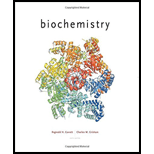
Concept explainers
Answers to all problems are at the end of this book. Detailed solutions are available in the Student Solutions Manual, Study Guide, and Problems Book.
Table 5.4 presents some of the many known mutations in the genes encoding the a- and
a. Some of these mutations affect subunit interactions between the Subunits. In an examination of the tertiary structure of globin chains, where would you expect to find amino acid changes in mutant globins that affect formation of the hemoglobin
b. Other mutations, such as the S form of theβ-globin chain, increase the tendency of hemoglobin tetramers to
Want to see the full answer?
Check out a sample textbook solution
Chapter 5 Solutions
Study Guide With Student Solutions Manual And Problems Book For Garrett/grisham's Biochemistry, 6th
- From the reaction data below, determine whether the reaction is first order or second order and calculate the rate constant. Time (s) 0 Reactant (mM) 5.4 1 4.6 2 3.9 3 3.2 4 2.7 5 2.3 Only a plot of In[reactant] versus t gives a straight line, so the reaction is s-1. . The negative of the slope, k, isarrow_forwardA protein has a molecular mass of 400 kDa when measured by size-exclusion chromatography. When subjected to gel electrophoresis in the presence of sodium dodecyl sulfate (SDS), the protein gives three bands with molecular masses of 180, 160, and 60 kDa. When electrophoresis is carried out in the presence of SDS and dithiothreitol (DTT), three bands again form, this time with molecular masses of 160, 90, and 60 kDa. How many subunits does the protein have, and what is the molecular mass of each? four subunits: 180, 160, 90, and 60 kDa three subunits: 180, 160, and 60 kDa three subunits: 160, 90, and 60 kDa four subunits: 160, 90, 90, and 60 kDa Correct Answerarrow_forwardCalculate KM and Vmax from the following data: KM= i Vmax [S] (μM) vo (mM.s-¹) 0.1 0.34 0.2 0.53 0.4 0.74 0.8 0.91 1.6 1.04 μM mM s-1arrow_forward
- Propose a detailed chemical mechanism for the enzyme catalyzed reaction below and briefly note similarities, if any, to enzymes that we've studied. CO2 + CO2 2 CO2 HO CH3arrow_forwardState and describe the four stages of protein formation, please include the types of bonds at each stage.arrow_forwardPlease state and describe the four different types of non-covalent interactions.arrow_forward
- Pls help with these three questionsarrow_forward11. Which of the compounds below is the major product of the following reaction sequence? NOTE: PCC is pyridinium chlorochromate 1. BH 3 PCC 2. H2O2, NaOH NH HN ΗΝ, A B C CH3NH2, NaBH3CN D E NHarrow_forward10. Which of the compounds below is the major organic product obtained from the following reaction sequence? Ph Ph Ph A B OH 1. EtMgBr H2CrO4 Zn(Hg), aq. HCI PhCHO ? 2. H₂O, H+ Ph. C D Ph "ར HO OH Earrow_forward
- 7. What is the major organic product obtained from the following reaction sequence? Ph A OH 99 Ph OH D Br HOCH2CH2OH H2SO4 1. Mg, Et₂O 2. PhCH2CHO HCI, H₂O Br OH Ph Ph OH B C Br OH Ph Earrow_forwardPls helparrow_forwardH₂N NH peptide_0e60 A dipeptide is made up of two (2) amino acids. The figure above shows one such dipeptide with an unknown sequence. Your task is to find out the two (2) letter sequence of this dipeptide.arrow_forward
 BiochemistryBiochemistryISBN:9781305577206Author:Reginald H. Garrett, Charles M. GrishamPublisher:Cengage Learning
BiochemistryBiochemistryISBN:9781305577206Author:Reginald H. Garrett, Charles M. GrishamPublisher:Cengage Learning
